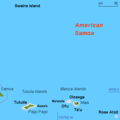Naval Base Samoa | |
|---|---|
 | |
 Map of Samoa | |
| Time zone | UTC+13c (WST) |

Naval Base Samoa, codename Operation Straw, was a number of United States Navy bases at American Samoa in the central Pacific Ocean. The bases were used during World War II to support the island hopping Pacific War efforts of the allied nations fighting the Empire of Japan.











